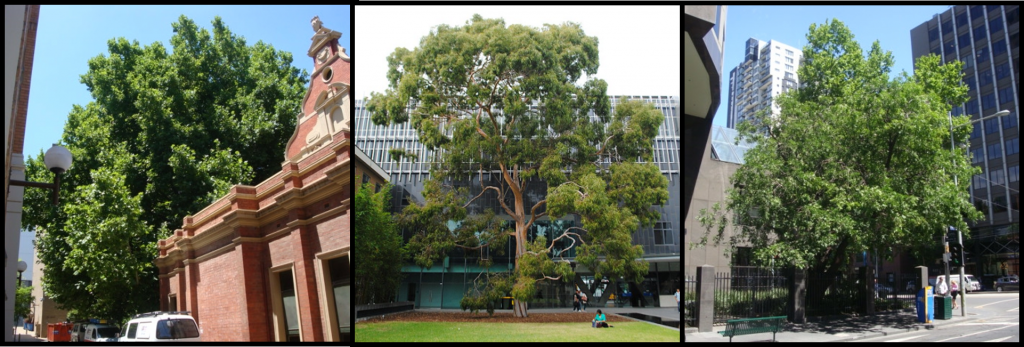Tackling protection for significant trees

The Trust has appeared at three Planning Panel hearings since June where Councils sought to place planning overlay controls on significant trees within the City of Melbourne, City of Casey and Cardinia Shire respectively. The three proposed Amendments were markedly different in their scope and scale.
City of Melbourne Amendment C212 – Environmental Significance Overlay (ESO) over 132 trees on 110 properties, as well as switching on tree controls in 8 existing Heritage Overlays (HOs).
City of Casey Amendment C148 – Environmental Significance Overlay (ESO) over 652 River Red Gums and 335 other native or exotic trees, plus four trees or groups of trees as new individual Heritage Overlays (HOs).
Cardinia Shire Amendment C162 – Heritage Overlay (HO) switched on at 25 properties to protect 170 trees.
So, what do we all generally agree on:
Limbs drop
Potential for limb failure is present in all threes, and although this risk can be managed through tree maintenance, it is not possible to eliminate all risk for any tree in any location. Trees, or parts of trees, posing immediate risk to persons or property are exempt from a permit requirement under the head clause for the ESO, and it is the responsibility of the owner to act to make the area safe.
Leaves fall
Management of fallen leaves, twigs and barks by cleaning gutters and raking the ground should be considered ordinary home maintenance and is the responsibility of the resident, and should not be considered when assessing a tree for inclusion in the Significant Tree Register.
Roots wander, but are not always the culprit
Damage to property caused by trees (including roots, branches, leaves and fruits) is the responsibility of the landholder, however property damage in densely developed urban areas becomes complex when multiple buildings, works or trees are in close proximity to the damage. The National Trust suggests that ESO schedules should include a decision guideline to ascertain the building is appropriately constructed and that evidence supports the notion that the tree in question is the cause of the property damage.
The ESO & the HO provide the most robust protection in urban and suburban locations
Choice of overlay is generally restricted to the ESO and the HO, as the ESO contains requirements for the construction of buildings and the carrying out of works as well as fence construction, subdivision and the removal, destruction or lopping of vegetation. The ESO has now been implemented for this purpose by Frankston City Council, Kingston City Council, Moonee Valley City Council, Melbourne City Council, and Casey City Council. The HO regulates the construction of buildings and the construction or carrying out of works, as well as the removal, destruction, pruning or lopping of trees if tree controls are switched on. The HO has now been implemented for this purpose by numerous Councils including, most recently, Melbourne and Cardinia.
Then, what might be improved?
- Application of the VPP Practice Note for ‘Vegetation Protection in Urban Areas’ is somewhat selective. One Council submitted that their significant tree study was consistent with the Practice Note with regards to the criteria for assessing significance. However, the same Council did not appear to follow the advice of the note in regard to the extent of the Heritage Overlay, which states that ‘as a guide, all land within five metres of the canopy edge of the tree or trees should be included in the overlay area’. The Practice Note does not give any direction to the extent of an ESO, so Council’s have variously applied the extent at 15 metres, 20 metres, and the nominal radius of the Tree Protection Zone (TPZ). This seems like it would be confusing for property owners who may assume that the extent of the overlay (which triggers the permit), and the extent of the TPZ (which protects the tree), are one and the same.
- Mapping of the HO is done by DTPLI, not the local government, and the extent of the Overlay on the exhibited maps should be either based on the Practice Note guide of canopy plus five metres, or by the TPZ. Exhibited maps should be double checked to ensure that they consistently reflect one of these measurements. This is important to provide certainty for property owners about the constraints within their property.
- Calculation of TPZs should now be in line with the Australian Standard AS4970-2009 Protection of trees on development sites. Some older significant trees studies completed up to or during 2009 have relied on the Matheny and Clark (1998) methodology, however we expect that there cannot be many using this methodology yet to come through the Amendment process – given that the standard has now been in place for five years!
- Most significant tree studies recommend a review of the TPZ if any development work is proposed adjacent to a significant tree, however there does not appear to be a mechanism in the Heritage Overlay controls to facilitate this.
- Replacement of heritage trees when they have reached their Safe Useful Life Expectancy is an appropriate conservation management approach. We encourage the use of a decision guideline addressing if/what replacement tree(s) are proposed. In practice, a significant tree could be replaced with a tree of the same species, or another species with similar aesthetics or form when considering the suitability of the original species in response to climate change and changing land use. Where a tree meets the criteria for contribution for landscape, or significant for its location, the replacement species should have the potential to achieve similar prominence in the landscape.
The National Trust is advocating for certainty for property owners and neighbours about constraints within their respective titles, certainty for Council’s planners by ensuring accurate evidence informs their decision, and certainty for the community that natural heritage assets will be conserved by their custodians.

Sugar Gum (Eucalyptus cladocalyx) at Melbourne University
+ There are no comments
Add yours